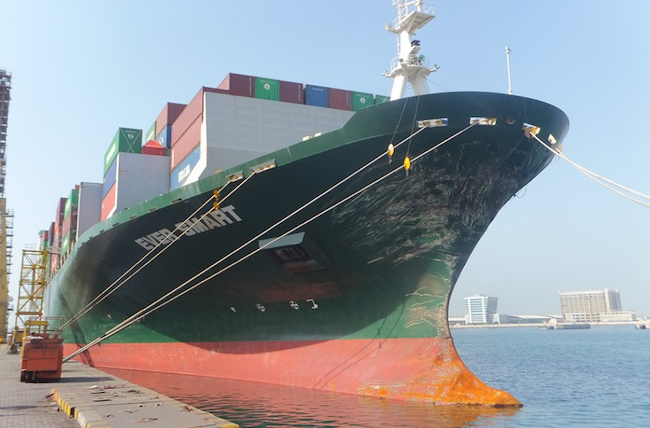

M/V “Ever Smart” in collision with VLCC “Alexandra 1” [2021] – further commentary

Vessels Crossing at the entrance to narrow channels – the COLREGS clarified by the English Supreme Court – Part II
In this second of two articles we consider the likely outcome on apportionment of liability and analyse the practical implications of this decision for mariners and fleet superintendents. We also point out circumstances in which there may be difficulties in applying the decision.
The Supreme Court, acknowledging established principles of interpretation of an international convention, recognised that the COLREGS, as the international “rules of the road”, should “be interpreted in a practical manner so as to provide clear and readily ascertainable navigational rules capable of application by all mariners”.
The entrance to a narrow channel, where it meets the open sea, will likely see approaching vessels typically doing one of three things:
First, where a vessel is approaching the entrance but heading across it;
Second, where a vessel is on her final approach to entering the channel and shaping to arrive on the starboard side;
Third, an approaching vessel intending and preparing to enter but waiting to do so, for example waiting for permission to proceed or for a pilot to embark, as was the case here.
In dealing with the third, as the Supreme Court pointed out, it must be the case that application of the crossing rules is not dependent upon either vessel being on a steady course. The COLREGS mention bearing not course. For example, the headings of vessels towing and many other types of vessel with poor seakeeping, yaw significantly from their intended course but may maintain nonetheless a steady bearing to another vessel. To hold otherwise would permit a vessel to exonerate herself from the COLREGS simply by altering her course from time to time.
This decision also deals with the second category, to the effect that the narrow channel rule should override the crossing rule from the time “when the approaching vessel is shaping to enter the channel” until she leaves the channel, presumably to return to sea. Clearly the narrow channel rule does not apply at sea. This aspect of the decision may give rise to difficulties, as discussed below.
It is uncontroversial that the collision rules must apply to the first category, depending on which vessel has the other on her starboard side.
On a wider point, the court applied established caselaw and commentary in rejecting a contention (on behalf of “A”) that rule 2 provided justification for a dis-application of or an alternative to the application of the crossing rules. It is settled that rule 2 imposes the ever-present duty of reasonable care and skill justifying a limited departure only in cases of necessity to avoid immediate danger or, to put it another way, that strict adherence of the rules governing conduct of vessels would actually cause danger.
Ultimate apportionment of liability
Unfortunately, the parties did not ask the Supreme Court to apportion liability and the case is being referred back to the Admiralty Court for re-apportionment. It will be regrettable if the case now settles as there will be no guidance as to the final division of liability in a collision situation of this nature.
It must follow however that “A”, as the putative give way vessel, will have to bear a greater proportion of blame having failed to take action to avoid collision. Her negligent reliance on an unverified third-party VHF conversation further compounds this highly causative error.
In reconsidering the faults of “ES”, her failure to act to avoid collision as the stand on vessel when it became apparent that avoiding action was not being taken by “A”, will be added to her catalogue of errors. Given her very poor seamanship, lookout and increasing speed, it seems likely that she will still be held to be bear the preponderance of blame. In most reported collision cases the give way ship in a crossing situation has been found at least 60% to blame. However, the Admiralty Court does not consider the various faults in isolation rather, as the Admiralty Judge held here, it takes into account the causative potency of each fault. Thus, the excessive speed of “ES” had a particular bearing on the apportionment of blame, simply because it was that particular fault that caused most of the damage. This will remain a significant factor weighing against “ES”.
Further, “A”s presence had been advised to the master of “ES” twice by the pilot. He could have “determined … by visual (or radar) observation … the approaching vessel’s course and speed.” He failed to do so. Failure to keep a good lookout might be considered the most grievous of breaches of the COLREGS for how can a ship take action to avoid a close quarters situation if it does not know another ship is there?
Why this case now sets an uncomfortable precedent
Ships leaving say the Thames, Maas, the Suez and Panama canals will now potentially be bound by the decision. Although in the Supreme Court case the leaving vessel was the stand on ship, the decision may correspondingly apply to make that vessel the give way ship. Thus, a ship in the channel leaving Colon, New York or Liverpool must under rule 15 give way to another ship, outside the channel, on her starboard bow, unless or until that vessel is finally lining up to enter the channel (whereupon the court held that the crossing rule is disapplied and both vessels become bound by rule 9(a)).
The Supreme Court correctly pointed out that the narrow channel rule does not address that situation so to avoid collision (at least not until the vessel is more or less aligned with the channel). It formed the view that the crossing rules dealt better with the majority of situations, applying of course only when the crossing gives rise to risk of collision.
It is however whilst the incoming vessel is shaping a course across the channel entrance to get on the starboard side at a time when a risk of collision exists (ie bearings remain steady) that the court’s ruling may be rather challenging to apply in a developing close quarters situation.
That is because such vessel is required to maintain course and speed as the stand on ship if she is to comply with the crossing rules, something that may however be particularly difficult if having to manoeuvre to embark a pilot.
It may also be impractical for the give way ship easily to avoid a close quarters situation where constrained within the channel by her draft or weather or tidal constraints or the need to maintain her speed for safe passage. In those circumstances collision may not be avoided by her slowing or altering course to starboard without, say, risk of hitting the bank, factors which may not necessarily always be apparent to the incoming vessel.
Ideally such situations would be avoided by the incoming vessel ensuring that her arrival is undertaken well in advance, or that she stays well clear of the exiting vessel before commencing her manoeuvre. Likewise the outgoing vessel may be able to adjust her speed in good time to resolve a developing close quarters situation within the constraints of remaining in the narrow channel. However, where the same pilot is destined to disembark the outbound vessel and board the incoming, it seems inevitable that these close quarters situations will continue to occur.
Guidance for mariners
Rules for the avoidance of collision were first adopted by international convention in the 19th century. Since that time the Admiralty division of the Commercial Court in London has been tasked with interpreting and applying them to apportion liability in collision cases.
Inasmuch as the pronouncements of that court upon the COLREGS of 1972, applying under SOLAS to shipping worldwide, may be taken as leading guidance for their application, we suggest that the following summary, in the light of this most recent decision, be considered by fleet managers in drawing up fleet circulars providing guidance on leaving or entering narrow channels:
Courts interpreting the COLREGS and apportioning blame between two vessels after a collision, have now clarified the relationship between the crossing rules (r.15-17) and the narrow channel rule (r.9(a)) in situations where one vessel is proceeding to exit and the other intending to enter such channel.
- The crossing rules have been held to apply where the bearings of two such vessel are steady, such as to give rise to a risk of collision and even if one ship is moving very slowly and awaiting a pilot.
- The narrow channel rule will only govern that situation once the vessel shaping to enter the channel has (safely) lined up to enter the starboard side of the entrance.
- Vessels intending to exit or enter a narrow channel should both proceed with caution, always maintaining a good lookout so to as determine whether a risk of collision exists, and accordingly what their responsibilities are.
- Specifically, the vessel that has the other on her starboard side on a steady bearing, should comply with the obligation to give way.
- Accordingly, a ship due to exit a narrow channel may be under an obligation to give way in accordance with the crossing rules.
- Bridge crew on such a vessel should not regard the narrow channel rule as permitting them to proceed on regardless of incoming traffic approaching towards the entrance, in particular traffic to starboard.
- The habit of vessels going Full Away on dropping outbound pilots short of the channel entrance is to be strongly discouraged.
- A careful handover from the pilot should always take place with the Master, officer of the watch and helmsman maintaining a vigilant lookout until clear, leaving calls and administration to later.
- Incoming vessels need to be aware that whatever speed they are making, if they are presenting a steady bearing (in which case a risk of collision is deemed to exist), the crossing rules apply.
- Picking up a pilot, whether or not in the designated pilot boarding area, before entering a river or harbour entrance is not an act that displaces the crossing rules.
- Only where an approaching ship is finally shaping, that is to say lining up, to enter the channel on the starboard side, will the narrow channel rule apply in preference to the crossing rules.
- Any ship navigating in a narrow channel which may find it difficult or impossible to “take early and substantial action to keep well clear” should make appropriate use of sound signals, judicious use of the VHF and pay particular attention to speed.
- Relatedly, where such vessel is constrained by her draft (rule 3(h)) and/or unable or constrained on account of crosswinds or tidal set to safely reduce speed as a means of collision avoidance, early appreciation of the developing situation is crucial irrespective of whether she is the actual or putative give way or stand on ship.
- Casual reliance upon VHF conversations is to be avoided.
- As a statement of the obvious, there will be no situation whereby the crossing rules will apply to one vessel and the narrow channel rule to the other.
- However, there remain other situations where the crossing rules will also apply to vessels in a narrow channel, for example where two channels join or intersect. In such situations the narrow channel rule applies but where a risk of collision develops between two oncoming vessels (that would not be avoided by both keeping to their starboard side of the channel), the vessels are obliged to comply with the crossing rules to avoid collision.
Similarly, it would be encouraging to believe that pilots and pilotage authorities might take their duties more seriously and not (i) succumb to prematurely disembarking the departing ship before being satisfied that the bridge crew are (ii) aware of the presence of vessels on a steady bearing, even if manoeuvering to await the pilot, and (iii) are wholly in command of the situation. Indeed, the practice of pilots hopping off one ship and onto another in close a quarters situation is one that calls for examination and clear guidance. Hitherto it is a practice that has kept us Admiralty lawyers quite busy.
*contribution by Martin Watson, Master Mariner solicitor
**This commentary represents the private opinions of the authors and is no substitute for detailed legal advice. All cases are highly fact dependent.
[1] Evergreen Marine (UK) Limited (Appellant) v Nautical Challenge Ltd (Respondent) [2021] UKSC 6

